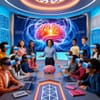As artificial intelligence (AI) becomes increasingly integrated into our lives, it’s clear that the role of human creativity is more vital than ever—especially in education. While AI is rapidly transforming industries, automating tasks, and revolutionizing processes, it cannot replicate the unique ability of humans to think critically, innovate, and solve complex problems. This presents a pressing challenge for education systems around the world: How can we adapt our teaching methods to ensure that students are prepared not just to use AI, but to collaborate with it and think creatively in an AI-driven world?
In many ways, AI is reshaping the landscape of education. From personalized learning platforms that tailor lessons to individual student needs, to AI-powered tools that assist teachers in grading and classroom management, technology is making education more efficient and accessible. But as these tools become more prevalent, there’s a growing concern about what might be lost in the process. If the focus shifts too much toward automation and standardized learning, will we lose the critical thinking, problem-solving, and creativity that are essential for real-world success?
The key to ensuring that AI is an asset, not a replacement, in education is to embrace the strengths of both human intelligence and machine learning. AI excels at processing large volumes of data, recognizing patterns, and performing repetitive tasks. However, it is the human capacity for imagination, empathy, and abstract thinking that allows for groundbreaking innovations and solutions. As AI takes over more routine tasks, the demand for human creativity in areas such as design, innovation, and leadership will only grow. The future workforce will need to be equipped with skills that complement AI, like collaboration, emotional intelligence, and critical problem-solving.
This calls for a transformation in how we approach education. Traditional models that emphasize rote memorization and standardized testing may no longer be enough. Instead, education systems must prioritize fostering creativity, curiosity, and adaptability. Students should be encouraged to explore, experiment, and engage in projects that allow them to apply knowledge in real-world contexts. Integrating AI into the classroom can be an opportunity for teachers to shift from a top-down, lecture-based approach to a more interactive, student-centered model. AI can help facilitate personalized learning, but it’s up to human educators to guide students in developing the skills that will be most valuable in an AI-augmented world.
Furthermore, educators themselves must be part of this transformation. As AI becomes a more prominent tool in the classroom, teachers will need ongoing training and professional development to effectively integrate technology into their teaching. However, the goal should not be to replace educators with AI, but to empower them. By leveraging AI to handle routine tasks, teachers can free up more time to engage with students on a personal level, providing mentorship and fostering the critical thinking and creativity that machines cannot replicate.


